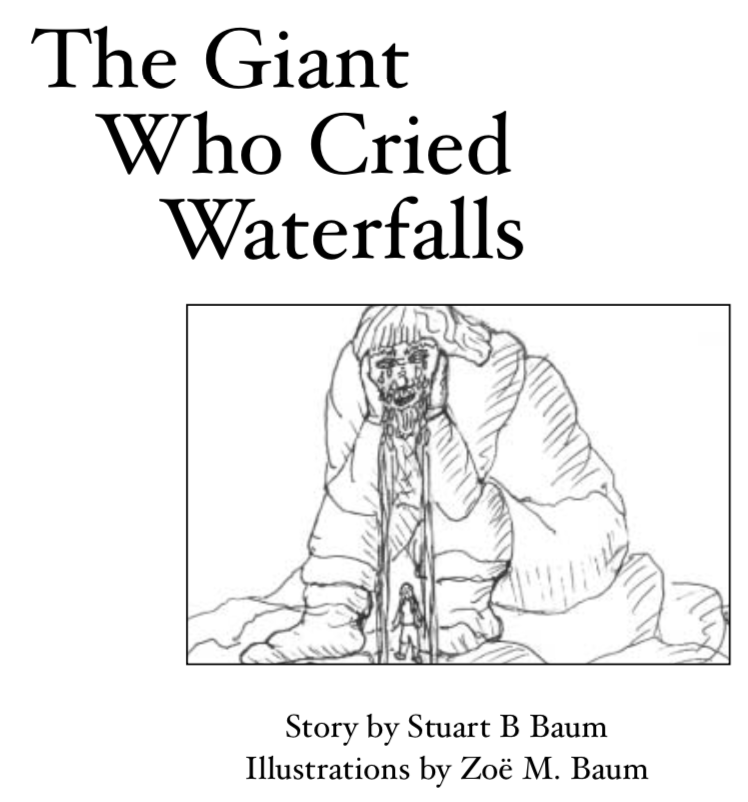2.1 Read About Positive Personal and Cultural Identity Through Stories
2.1E The Giant Who Cried Waterfalls - Part One - Setting & Character

In this lesson (parts one and two), you will read and respond to a story called, "The Giant Who Cried Waterfalls".
Does the title and the cover picture help you to guess the genre? What clues do they give?
What genre do you predict fits this story: realistic, historical, adventure, mystery, fantasy, science fiction, humour, or folktale/traditional?
Setting
Stories usually start by introducing the setting and the main characters. Setting is the WHERE and WHEN a story takes place and the resulting ATMOSPHERE.
1. The location of the story - The author usually describes the setting(s) in a story with lots of detail. This helps the reader really picture the scene.
- In a big city near the border between British Columbia and the United States, in the back alley, on a distant planet, etc.
2. The time of the story - The time when a story takes place affects many things. If the story were to take place in the early 1800s, for instance, then everything the characters do, wear, say, and how they live must match the time period.
- A long time ago, today, 2050, during a war, in the future...
3. The mood or atmosphere of the story (which is reflected in the setting) - Is it a happy place? A sad place? A scary place?Authors carefully choose their settings in order to create a certain mood.
- Frightening: a story set in a haunted house on a dark, stormy night.
- Peaceful and relaxing: a tropical island with a gentle breeze and waves lapping against the shore.
Skillful writers often take you through many different moods as they tell their story. Click on the location, time, and atmosphere to learn more about these aspects of setting.
Now, read the beginning of the story.
First reading:
- Try to get the "gist" of the text - a sense of what it is about and a sense of how it may be read.
- Try to make a picture in your mind of what is happening.
- Ask yourself questions.
- Stop and predict what you think will happen next.
- Look for big ideas!
- What do you find out about the setting?
This story starts most of the way up a tall mountain.
To get there, we have to first take a plane halfway around the world. Then we have to take a long train ride, of about five hours, to the bottom of a large mountain range. That’s as far as the train goes, so we have to take a bus from that town to an even smaller town. It’s not that far, but the roads are so winding and so thin that we have to stop to wait for cars, carts, other buses, and frequently sheep and goats to go past before we can continue on our way. Finally, we arrive at a smaller town at the bottom of the mountain.
Look up the mountain. Towards the top, you can see a small village with perhaps fifteen houses and two larger buildings. That’s the village we need to get to. You can’t see the very top of the mountain. It’s above the clouds.
Before we travel up, take a good look at the mountain. See how the pine trees get smaller and smaller as they get closer and closer to the village? See how the mountain becomes more rocks than trees as you look past the village? It’s almost all boulders and crags as it disappears into the clouds.
See the village? All the houses and the two larger buildings are built in a semi-circle around a small lake. Now, take a good look at that lake. You’d expect a mountain lake to be bright blue like the sky, but it’s greyer and milkier than that.
But here’s what you really need to see. Look behind the lake. Notice the two thin lines of water running up the mountain and disappearing into the clouds? These are two thin waterfalls, which, of course, travel down from the top of the mountain and into the lake. They’re quite beautiful, these two thin waterfalls. They’re also magic, or so many people think. That’s why so many people go to the lake to cure their aches and pains, among other things. And they pay good money to do this. In fact, many of the people in the village earn their living from the money people pay to bathe in and drink this lake water.
~~~~
Are you ready to walk up? It’s a long, long walk. But it’ll be worth it; you’ll see.
 |
Second reading: This is usually a slower read, where you try to understand the text better. As you read, find and record examples of Complete the "Setting" activity in your Learning Guide. Go back and reread for more details, if needed. Then, return to this lesson. |
You are about to meet Bonnie, a nine year old from the village. She has to make some tough decisions and even goes against her parents very strict directions. What do you think of Bonnie? Would you have made the same choices? What do her words, thoughts, and actions tell us about her?
Read from page 4 to the middle of page 7, paying close attention to what and how we learn about Bonnie. Then, complete the character analysis activity. You will read the next story in part two of this lesson.
 |
Click here for the story: The Giant Who Cried Waterfalls by Stuart Baum. Read pages 4-6. Complete the "Character Analysis" activity in your Learning Guide. |